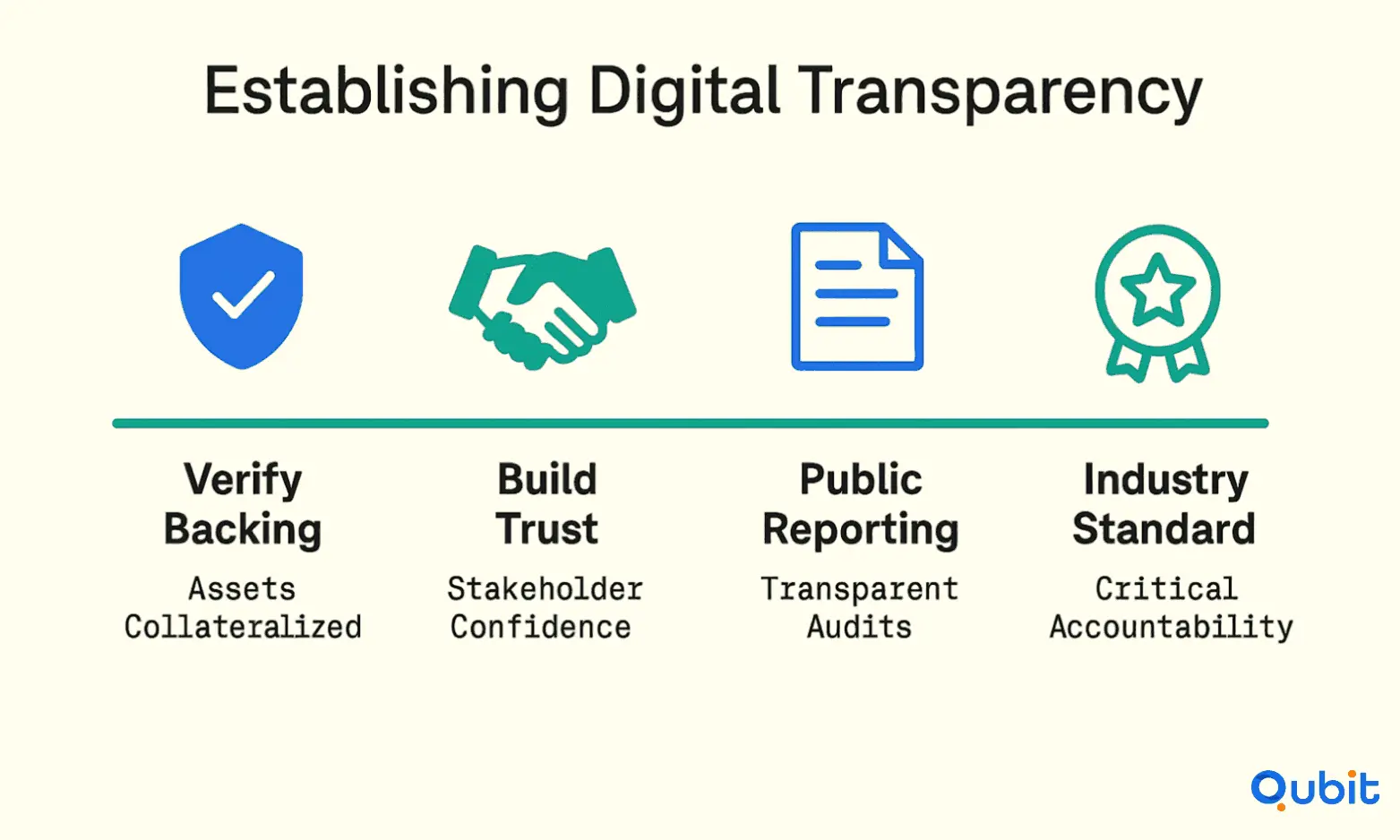Transparency has become a cornerstone in the world of digital assets, especially as blockchain-based ventures seek to secure funding. Proof-of-reserves, a mechanism that verifies the collateralization of assets, plays a pivotal role in building trust among investors and regulators. By demonstrating that funds are backed by tangible reserves, blockchain projects can enhance their credibility and compliance.
Your exploration of proof-of-reserves naturally connects with insights from blockchain startup fundraising strategies that frame broader market trends in blockchain financing. This blog delves into the importance of audits and reporting standards, explaining how they contribute to transparency and investor confidence. Let’s jump right in to uncover how these practices shape the fundraising landscape.
Proof of Reserve Overview: Establishing Digital Transparency
Proof of Reserve (PoR) has emerged as a vital mechanism for ensuring the integrity of digital asset collateralization within the cryptocurrency industry. This framework allows crypto businesses to demonstrate that their digital assets are adequately backed, fostering trust among depositors and stakeholders.

PoR achieves transparency by enabling public reserve reporting or conducting independent audits, which verify the sufficiency of digital asset reserves. These measures provide depositors with confidence that their funds are safeguarded and not mismanaged. Research published on SSRN in July 2024 underscores the importance of PoR as a critical tool for verifying the backing of digital assets, positioning it as a cornerstone of accountability in the blockchain ecosystem.
A review of transparency measures resonates with discussions on blockchain AML KYC investors, outlining how compliance protocols bolster trust in fundraising.
RegTech Integrations: Automated Compliance Platforms
As transaction volumes spike and regulations evolve, manual compliance checks can’t keep pace. Enter RegTech (Regulatory Technology) integrations, plug-and-play APIs and platforms that automate your AML/KYC workflows end to end.
Why It Matters
- Instant Watchlist Screening: Every new user and every transaction is cross-checked in real time against global sanctions and PEP lists, no more risky slip-throughs.
- Smarter Case Management: Flags get bundled into a unified dashboard. Your compliance officer sees only the truly high-risk cases, freeing them from drowning in low-priority noise.
- Continuous Monitoring: 24/7 surveillance without adding headcount. Volume spikes? The system scales automatically.
Core Capabilities to Look For
- API-Based Onboarding: Document scanning, OCR, and data validation in one call.
- Dynamic Risk Scoring: Machine-learning models adjust thresholds based on customer behavior patterns.
- Automated SAR Filing: Generate Suspicious Activity Reports with minimal manual input.
- Audit Trail & Reporting: Built-in logs and exportable reports you can hand straight to auditors.
Top RegTech Vendors
- Scorechain: Transaction monitoring tailored to blockchain—with pre-built dashboards for DeFi and crypto.
- Comply Advantage: Real-time sanctions and politically exposed persons (PEP) screening, with behavioral risk insights.
- SumSub: End-to-end identity verification, including liveness checks and biometric authentication.
Proof of Reserve for Off-Chain Assets: Ensuring Stablecoin Integrity
Stablecoins have become a cornerstone of decentralized finance (DeFi), offering stability and liquidity in a volatile crypto ecosystem. However, their reliability hinges on transparent collateralization, particularly for fiat-backed reserves. Proof of Reserve (PoR) systems play a pivotal role in ensuring that stablecoins are fully backed by off-chain assets, fostering trust and accountability among users.
The Importance of Proof of Reserve in Stablecoins
Fiat-backed stablecoins, such as TrueUSD (TUSD), rely on off-chain reserves to maintain their value. Without a robust mechanism to verify these reserves, users are left questioning the integrity of the stablecoin’s backing. Proof of Reserve systems address this challenge by providing real-time, cryptographically verified data about the collateralization of stablecoins. This transparency is essential, especially in a global stablecoin market valued at more than a hundred billion dollars, where even minor discrepancies can have significant consequences.
Chainlink’s Role in Delivering Reliable Collateralization Data
Chainlink’s Proof of Reserve Secure Mint system has emerged as a trusted solution for verifying stablecoin reserves. By cryptographically guaranteeing that newly minted tokens are fully backed by reserves, Chainlink enhances the security and transparency of fiat-backed stablecoins. For example, TrueUSD’s secure minting with proof of reserves demonstrates how Chainlink’s system ensures that TUSD tokens are backed by off-chain bank reserves. This integration not only enforces secure minting but also provides on-chain data about the reserves, offering users unparalleled confidence in the stablecoin’s integrity.
Other fiat-backed stablecoins, such as PoundToken, have also adopted Chainlink’s Proof of Reserve system to bolster transparency and maintain user trust. These implementations highlight the growing importance of PoR systems in safeguarding the stability and reliability of stablecoins across various currencies.
Proof of Reserve in Traditional Markets and Tokenized Assets: Bridging Real-World and Digital Assets
Transparency is the cornerstone of trust in both traditional and digital financial ecosystems. Proof of Reserve (PoR) has emerged as a pivotal mechanism to enhance transparency for tokenized real-world assets, including real estate, commodities, and fiat-backed instruments. By verifying clear asset backing, PoR facilitates trust-minimized tokenization, enabling investors and stakeholders to confidently engage with tokenized assets.
Expanding PoR Beyond Stablecoins
While PoR models initially gained traction with USD-backed stablecoins, their application is now broadening to encompass diverse asset classes. This expansion includes other fiat currencies, tokenized commodities like gold, and real-world assets such as real estate. For instance, asset tokenization can thrive when PoR mechanisms verify the backing of these assets across various categories. This broader adoption not only strengthens transparency but also opens new avenues for integrating traditional markets with blockchain technology.
Building Trust in Tokenized Real-World Assets
Tokenization of real-world assets relies heavily on trust, and PoR plays a critical role in establishing this trust. By providing verifiable evidence of asset backing, PoR ensures that tokenized assets are not only credible but also auditable. This trust-minimized approach reduces reliance on intermediaries, making it easier for investors to participate in markets traditionally dominated by centralized entities.
For comparative insights on auditing and how regulatory frameworks shape decentralized fundraising, explore our article on blockchain fundraising regulation.
The Future of PoR in Asset Tokenization
As PoR continues to evolve, its application across diverse asset classes will likely redefine the landscape of tokenization. From enabling fractional ownership of real estate to verifying the backing of tokenized commodities, PoR is set to bridge the gap between traditional and digital assets. This integration not only enhances transparency but also paves the way for broader adoption of blockchain-based solutions in traditional markets.
By embracing PoR, businesses and investors can unlock the full potential of tokenized assets, fostering innovation and trust in the financial ecosystem.
Proof of Reserve for Cross-Chain Assets and Wrapped Token Bridges: Ensuring Liquidity and Security
The ability to verify collateralization in real time is a cornerstone of trust in blockchain ecosystems. Proof-of-reserve (PoR) mechanisms play a critical role in ensuring that cross-chain assets and wrapped token bridges remain secure and liquid. By providing transparent, on-chain evidence of collateral backing, PoR systems help users and institutions monitor the health of these assets with precision.
Wrapped tokens, which represent assets from one blockchain on another, rely heavily on collateralization to maintain their value. Without robust PoR mechanisms, the risk of undercollateralization could lead to liquidity crises or even systemic failures. Real-time detection of such issues ensures that corrective measures can be taken promptly, safeguarding both liquidity and capital efficiency across decentralized finance (DeFi) platforms.
PoR systems also enhance user confidence by offering transparency into the reserves backing wrapped tokens and cross-chain assets. This transparency is vital for fostering trust in multi-chain ecosystems, where assets frequently move between blockchains. By mitigating risks associated with undercollateralization, PoR mechanisms not only protect individual users but also contribute to the stability of the broader blockchain network.
For institutions and developers, implementing PoR systems is more than a technical necessity—it’s a strategic advantage. These mechanisms provide a clear framework for accountability, ensuring that wrapped tokens and cross-chain assets remain viable and secure in the long term.
Proof of Reserve for Liquid Staking Derivatives: Enhancing Staking Transparency
Liquid staking derivatives (LSDs) have emerged as a transformative solution in the staking ecosystem, offering tokenized representations of staked assets. These derivatives allow investors to maintain liquidity while participating in staking rewards. However, their reliance on proof-of-reserve (PoR) mechanisms is critical for ensuring transparency and trust.
Proof-of-reserve systems verify that LSDs are fully backed by the underlying staked assets, providing assurance to investors and stakeholders. Without this verification, concerns about over-collateralization or mismanagement of funds could undermine confidence in staking platforms. By demonstrating full collateralization, PoR strengthens the integrity of liquid staking protocols and fosters trust among users.
For staking platforms, implementing robust PoR mechanisms not only enhances transparency but also positions them as reliable custodians of staked assets. This trust is essential for attracting and retaining investors in a competitive market.
Proof of Reserve as a DeFi Circuit Breaker: Mitigating Systemic Risk
The decentralized finance (DeFi) ecosystem thrives on transparency and trust, yet systemic risks and fraudulent activities remain persistent challenges. Proof of Reserve (PoR) offers a proactive solution by acting as a circuit breaker, ensuring protocols maintain operational integrity even during critical moments.
Real-Time Audits: A Safety Net for DeFi Protocols
Proof of Reserve integrates real-time audit mechanisms to monitor the health of a protocol’s reserves. When reserves drop below predefined thresholds, these audits can trigger automatic halts in operations, preventing further damage. This immediate response mechanism minimizes the risk of cascading failures across interconnected DeFi systems, safeguarding user assets and maintaining market stability.
Preventing Fraudulent Asset Minting
The use of PoR as a circuit breaker also addresses fraudulent activities, such as unauthorized asset minting. By continuously verifying reserve levels, PoR ensures that every minted asset is backed by actual reserves. This transparency deters malicious actors and reinforces trust among users, creating a more secure DeFi environment.
Conclusion
Transparency and trust are cornerstones of successful asset management, whether in digital or traditional markets. Proof of Reserve (PoR) plays a pivotal role in ensuring these values by providing clear, real-time insights into asset holdings. Chainlink’s advanced auditing capabilities further enhance this process, acting as a safeguard against potential risks in decentralized finance (DeFi). By implementing robust, data-driven reporting standards, businesses can foster greater investor confidence while meeting compliance requirements.
At Qubit Capital, we understand the importance of effective communication in building investor trust. If you're ready to elevate your fundraising efforts and connect with the right investors, our Investor Outreach service is designed to help you achieve your goals. Let us support you in creating meaningful connections that drive success.
Key Takeaways
- Proof-of-reserves are essential for verifying digital asset collateralization and ensuring transparency.
- Chainlink’s real-time auditing tools facilitate autonomous on-chain verification.
- Transparent PoR systems build investor trust in both digital and tokenized traditional assets.
- Effective PoR mechanisms can serve as circuit breakers to mitigate systemic risks in DeFi.
- Integrating robust reporting standards strengthens fundraising efforts by reducing risk and enhancing compliance.
Frequently asked Questions
What is proof of reserves in blockchain?
Proof of reserves in blockchain refers to a cryptographic method used by cryptocurrency exchanges and custodians to demonstrate that they hold sufficient assets to cover their users’ deposits. This process involves publishing verifiable data, often through Merkle trees, to confirm the existence of funds without compromising user privacy. By providing transparency, proof of reserves builds trust within the crypto ecosystem.


 Back
Back



